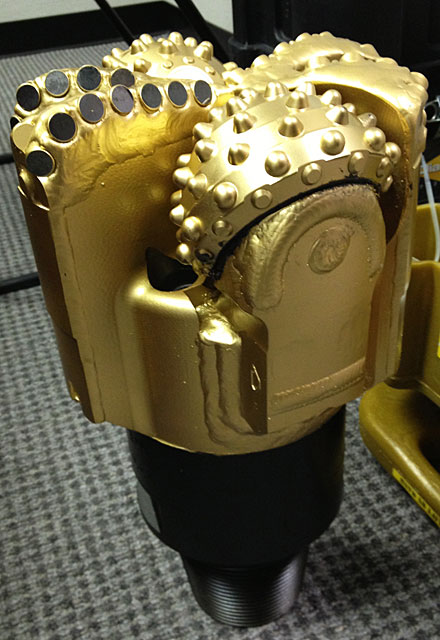First, some simple oilfield visual mathematics:

You probably (possibly?) recognize those as the business end of drill bits, the tools that are used to bore holes down to where the oil and gas lives. The first one is a roller cone bit, and it operates like its name implies. Those three cones turn on bearings, and they crush or chip the rock in the process. Roller cone bits are generally used when drilling in very hard formations.
The one in the middle is a polycrystalline diamond compact (PDC) bit. You can’t see them in the photo, but the flat side of each of the seven “blades” is lined with disks made of synthetic industrial diamonds. Those ultra-tough disks shear or cut the rock as the bit turns. They are most effective in softer rock.
But we’re here to talk about the result of combining these two designs, which is referred to as a hybrid bit. There are different types of hybrid bits, but as you can see in the picture, this particular version consists of some conventional roller cones alternating with diamond-impregnated blades. As you might guess, this combination is designed to drill in formations that are not homogenous. Specifically, a hybrid bit will [theoretically] make drilling in rock that’s interspersed with chert much less painful. Chert is a flinty, crystalline substance that can destroy a bit, and it’s the bane of our existence in some areas of the Permian Basin, especially when drilling horizontal wellbores.
The reason I’m writing about this seemingly random topic is that our company’s local region is about to run its first hybrid bit and we’re all pretty excited about it. Lots of people dropped by the office yesterday to take photos when our bit showed up. Photos like these:


This is a Kymera™ hybrid drill bit manufactured by Baker Hughes to our specifications. You may notice some differences in this design and the one shown at the top of the page. The most obvious is that our bit has only two roller cones but four PDC blades (and the diamond discs are seen much more clearly). I’m not a drilling or bit engineer so I can’t explain why we think this design is appropriate for the specific conditions we’ll be drilling in, but it’s safe to say that it’s a bit (ha!) of an experiment. If it works as we hope, this hundred-pound hunk of metal will knock a few days off our normal drilling time. Since a long-lateral horizontal well might cost more than $20,000 per day to drill, the potential savings are nothing to sneeze at.
I’ve barely scratched the surface of the technological considerations related to drilling an oil well. I’m of the opinion that the typical American has no concept of just how complex the search for oil and gas has become. Jed Clampett may have discovered oil by firing a rifle into the ground, but we’re not that fortunate.
Discover more from The Fire Ant Gazette
Subscribe to get the latest posts sent to your email.
